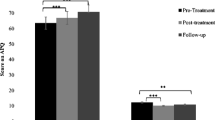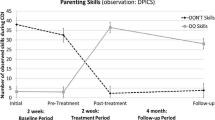Abstract
Two variants of a behavioral family intervention (BFI) program known as Triple P were compared using 87 preschoolers with co-occurring disruptive behavior and attentional/hyperactive difficulties. Families were randomly allocated to enhanced BFI (EBFI), standard BFI (SBFI), or a waitlist (WL) control group. At postintervention both BFI programs were associated with significantly lower levels of parent-reported child behavior problems, lower levels of dysfunctional parenting, and greater parental competence than the WL condition. The EBFI condition was also associated with significantly less observed child negative behavior in comparison to the WL. The gains achieved at postintervention were maintained at 1-year follow-up. Contrary to predictions, the enhanced program was not shown to be superior to the standard program using any of the outcome measures at either postintervention or follow-up. Each of the programs produced significant reductions in children's co-occurring disruptive behavior and attentional/hyperactive difficulties with 80% of the children showing clinically reliable improvement in observed negative behavior from preintervention to follow-up.
Similar content being viewed by others
REFERENCES
Abikoff, H., & Klein, R. G. (1992). Attention-deficit hyperactivity and conduct disorder: Comorbidity and implications for treatment. Journal of Consulting and Clinical Psychology, 60, 881-892.
American Psychiatric Association. (1994). Diagnostic and statistical manual of mental disorders (4th ed.). Washington, DC: Author.
Arnold, D. S., O'Leary, S. G., Wolff, L. S., & Acker, M. M. (1993). The Parenting Scale: A measure of dysfunctional parenting in discipline situations. Psychological Assessment, 5, 137-144.
Barkley, R. A. (1997). Behavioral inhibition, sustained attention and executive functions: Constructing a unified theory of ADHD. Psychological Bulletin, 121, 65-94.
Barkley, R. A. (1998). Attention-deficit hyperactivity disorder. A handbook for diagnosis and treatment (2nd ed.). New York: Guilford Press.
Barkley, R. A., Shelton, T. L., Crosswait, C., Moorehouse, M., Fletcher, K., Barrett, S., et al. (1996). Preliminary findings of an early intervention with aggressive hyperactive children. Annals of the New York Academy of Science, 794, 277-289.
Barkley, R. A., Shelton, T. L., Crosswait, C., Moorehouse, M., Fletcher, K., Barrett, S., et al. (2000). Multi-method psycho-educational intervention for preschool children with disruptive behaviour: Preliminary results at post-treatment. Journal of Child Psychology and Psychiatry, 41, 319-332.
Beck, A. T., Rush, A. J., Shaw, B. F., & Emery, G. (1979). Cognitive therapy of depression. New York: Guilford Press.
Beck, A. T., Steer, R. A., & Garbin, M. G. (1988). Psychometric properties of the Beck Depression Inventory: Twenty-five years of evaluation. Clinical Psychology Review, 8, 77-100.
Burns, G. L., & Patterson, D. R. (2000). Factor structure of the Eyberg Child Behavior Inventory: A parent rating scale of oppositional defiant behavior towards adults, inattentive behavior, and conduct problems. Journal of Clinical Child Psychology, 29, 569-577.
Campbell, S. B. (1995). Behavior problems in preschool children: A review of recent research. Journal of Child Psychology and Psychiatry, 36, 113-149.
Campbell, S. B. (2000). Attention-Deficit/Hyperactivity Disorder: A developmental view. In A. J. Sameroff, M. Lewis, & S. M. Miller (Eds.), Handbook of developmental psychopathology (pp. 383-401). New York: Kluwer Academic/Plenum Publishers.
Chamberlain, P., & Reid, J. B. (1987). Parent observation and report of child symptoms. Behavioral Assessment, 9, 97-109.
Dadds, M. R., & Powell, M. B. (1991). The relationship of interparental conflict and global marital adjustment to aggression, anxiety, and immaturity in aggressive and nonclinic children. Journal of Abnormal Child Psychology, 19, 553-567.
Dadds, M. R., Schwartz, S., & Sanders, M. R. (1987). Marital discord and treatment outcome in the treatment of child conduct disorders. Journal of Consulting and Clinical Psychology, 55, 396-403.
Daniel, A. E. (1983). Power, privilege and prestige: Occupations in Australia. Melbourne, Victoria, Australia: Longman-Chesire.
DuPaul, G. J., McGoey, K., Eckert, T. L., & Vanbrakle, J. (2001) Preschool children with Attention-Deficit/Hyperactivity Disorder: Impairments in behavioral, social and school functioning. Journal of the American Academy of Child and Adolescent Psychiatry, 40, 508-515.
Eyberg, S. M., & Pincus, D. (1999). Eyberg Child Behavior Inventory and Sutter-Eyberg Student Behavior Inventory—Revised: Professional manual. Odessa, FL: Psychological Assessment Resources.
Eyberg, S. M., & Ross, A. W. (1978). Assessment of child behavior problems: The validation of a new inventory. Journal of Clinical Psychology, 16, 113-116.
Gibaud-Wallston, J., & Wandersman, L. P. (1978, August–September). Development and utility of the Parenting Sense of Competency Scale. Paper presented at the 86th Annual Convention of the American Psychological Association, Toronto, Ontario, Canada.
Hazell, P. (2000). Attention deficit hyperactivity disorder in preschool children. In R. Kosky, A. O'Hanlon, G. Martin, & C. Davis (Eds.), Clinical approaches to early intervention in child and adolescent mental health (Vol. II). Adelaide: Australian Early Intervention Network for Mental Health in Young People.
Huesmann, L. R. & Moise, J. F. (1999). Stability and continuity of aggression from early childhood to young adulthood. In D. J. Flannery & C. R Huff (Eds.), Youth violence: Prevention, intervention and social policy. Washington, DC: American Psychiatric Press.
Jacobson, N. S., & Traux, P. (1991). Clinical significance: A statistical approach to defining meaningful change in psychotherapy research. Journal of Consulting and Clinical Psychology, 59, 12-19.
Johnston, C., & Mash, E. J. (1989). A measure of parenting satisfaction and efficacy. Journal of Clinical Child Psychology, 18, 167-175.
Johnston, C., & Mash, E. J. (2001). Families of children with Attention-Deficit/Hyperactivity Disorder: Review and recommendations for future research. Clinical Child and Family Psychological Review, 4, 183-207.
Kazdin, A. E. (2000). Psychotherapy for children and adolescents: Directions for research and practice. New York: Oxford University Press.
Kuhne, M., Schachar, R., & Tannock, R. (1997). Impact of comorbid oppositional or conduct problems on attention-deficit hyperactivity disorder. Journal of the American Academy of Child and Adolescent Psychiatry, 36, 1715-1725.
Lavigne, J. V., Arend, R., Rosenbaum, D., Binns, H. J., Christoffel, K. K., & Gibbons, R. D. (1998). Correlates and predictors of stable case status (Psychiatric Disorders with Onset in preschool years, Part 2). Journal of the American Academy of Child and Adolescent Psychiatry, 37, 1255-1262.
Lovibond, P. F., & Lovibond, S. H. (1995a). The structure of negative emotional states: Comparison of the Depression Anxiety Stress Scales (DASS) with the Beck Depression and Anxiety Inventories. Behaviour Research and Therapy, 33, 335-343.
Lovibond, S. H., & Lovibond, P. F. (1995b). Manual for the Depression Anxiety Stress Scales (2nd ed.). Sydney, New South Wales, Australia: Psychology Foundation of Australia.
Markie-Dadds, C., Sanders, M. R., & Turner, K. M. T. (2000). Every parent's family workbook. Brisbane, Queensland, Australia: Families International Publishing.
Markie-Dadds, C., Turner, K. M. T., & Sanders, M. R. (1998). Every parent's supplementary workbook. Brisbane, Queensland, Australia: Families International Publishing.
McLoyd, V. C., Ceballo, R., & Mangelsdorf, S. C. (1997). The effects of poverty on children's socioemotional development. In J. D. Noshpitz (Ed.), Handbook of child and adolescent psychiatry (Vol. 4., pp. 191-206). New York: Wiley.
McMahon, R. J. (1999). Parent training. In S. W. Russ & T. Ollendick (Eds.), Handbook of psychotherapies with children and families (pp. 153-180). New York: Plenum.
Milner, J. S. (1986). The Child Abuse Potential Inventory: Manual (2nd ed.). Dekalb, IL: Psytec.
Moos, R. H., & Moos, B. S. (1981). Family Environment Scale Manual. Palo Alto, CA: Consulting Psychologist Press.
Newcorn, J. H., & Halperin, J. M. (1994). Comorbidity among disruptive disorders: Impact on severity, impairment and response to treatment. In L. L. Greenhill (Ed.), Child and adolescent psychiatric clinics of North America (Vol. 3, pp. 227-252). Philadelphia: W. B. Saunders.
Patterson, G. R. (1982). Coercive family process. Eugene, OR: Castalia.
Patterson, G. R. (1995). Coercion as the basis of early age of onset for arrest. In J. McCord (Ed.), Coercion and punishment in long-term perspectives (pp. 81-105). New York: Cambridge University.
Pisterman, S., Firestone, P., McGrath, P., Goodman, J. T., Webster, I., Mallory, R., et al. (1992). The role of parent training in treatment of preschoolers with ADDH. American Journal of Orthopsychiatry, 62, 397-408.
Pisterman, S., McGrath, P., Firestone, P., Goodman, J. T., Webster, I., & Mallory, R. (1989). Outcome of parent-mediated treatment of preschoolers with attention deficit disorder with hyperactivity. Journal of Consulting and Clinical Psychology, 57, 628-635.
Prinz, R. J., & Miller, G. E. (1994). Family-based treatment for childhood antisocial behavior: Experimental influences on dropout and engagement. Journal of Consulting and Clinical Psychology, 62, 645-650.
Robinson, E. A., Eyberg, S. M., & Ross, A. W. (1980). The standardization of an inventory of child conduct problem behaviors. Journal of Clinical Child Psychology, 9, 22-29.
Rutter, M., Geller, H., & Hagell, A. (1998). Antisocial behaviour by young people. Cambridge: Cambridge University.
Sanders, M. R. (1992). Every parent: A positive guide to children's behaviour. Sydney, New South Wales, Australia: Addison-Wesley.
Sanders, M. R. (1999). Triple P-Positive Parenting Program: Towards an empirically validated multilevel parenting and family support strategy for the prevention of behavior and emotional problems in children. Clinical Child and Family Psychology Review, 2, 71-90.
Sanders, M. R., & Christensen, A. P. (1985). A comparison of the effects of child management and planned activities training in five parenting environments. Journal of Abnormal Child Psychology, 13, 101-117.
Sanders, M. R., & Dadds, M. R. (1993). Behavioral family intervention. Needham Heights, MA: Allyn and Bacon.
Sanders, M. R., Markie-Dadds, C., Tully, L. A., & Bor, W. (2000). The Triple P-Positive Parenting Program: A comparison of enhanced, standard and self-directed behavioral family intervention for parents of children with early onset conduct problems. Journal of Consulting and Clinical Psychology, 68, 624-640.
Sanders, M. R., Markie-Dadds, C., & Turner, K. M. T. (1998). Practitioner's manual for Enhanced Triple P. Brisbane, Queensland, Australia: Families International Publishing.
Sanders, M. R., Markie-Dadds, C., & Turner, K. M. T. (2000). Practitioner's manual for Standard Triple P. Brisbane, Queensland, Australia: Families International Publishing.
Sanders, M. R., & McFarland, M. (2000). Treatment of depressed mothers with disruptive children: A controlled evaluation of cognitive behavioral family intervention. Behavior Therapy, 31, 89-112.
Sanders, M. R., Waugh, L., Tully, L., & Hynes, K. (1996). The Revised Family Observation Schedule (3rd ed.). Brisbane, Queensland, Australia: Parenting and Family Support Centre.
Schachar, R. (1991). Childhood hyperactivity. Journal of Child Psychology and Psychiatry, 2, 155-191.
Sonuga-Barke, E. J. J., Daley, D., Thompson, M., Laver-Bradbury, C., & Weeks, A. (2001). Parent-based therapies for preschool attention-deficit/hyperactivity disorder: A randomized, controlled trial with a community sample. Journal of American Academy of Child and Adolescent Psychiatry, 40, 402-408.
Speltz, M., McClellan, J., DeKlyen, M., & Jones, K. (1999). Preschool boys with Oppositional Defiant Disorder: Clinical presentation and diagnostic change. Journal of the American Academy of Child and Adolescent Psychiatry, 38, 838-846.
Stevenson, J., & Goodman, R. (2001). Association between behavior at age 3 years and adult criminality. British Journal of Psychiatry, 179, 197-202.
Webster-Stratton, C. (1994). Advancing videotape parenting training: A comparison study. Journal of Consulting and Clinical Psychology, 62, 583-593.
Webster-Stratton, C., Hollinsworth, T., & Kolpacoff, M. (1989). The long-term effectiveness and clinical significance of three cost-effective training programs for families with conduct-problem children. Journal of Consulting and Clinical Psychology, 57, 550-553.
Author information
Authors and Affiliations
Rights and permissions
About this article
Cite this article
Bor, W., Sanders, M.R. & Markie-Dadds, C. The Effects of the Triple P-Positive Parenting Program on Preschool Children with Co-Occurring Disruptive Behavior and Attentional/Hyperactive Difficulties. J Abnorm Child Psychol 30, 571–587 (2002). https://doi.org/10.1023/A:1020807613155
Issue Date:
DOI: https://doi.org/10.1023/A:1020807613155




